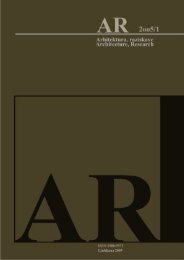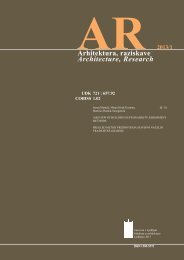2oo2/1 - Fakulteta za arhitekturo - Univerza v Ljubljani
2oo2/1 - Fakulteta za arhitekturo - Univerza v Ljubljani
2oo2/1 - Fakulteta za arhitekturo - Univerza v Ljubljani
You also want an ePaper? Increase the reach of your titles
YUMPU automatically turns print PDFs into web optimized ePapers that Google loves.
industry and today as a home office virtually connected to the<br />
wide world.<br />
ENVIRONMENT<br />
Mankind has evolved and took separated evolutionary direction<br />
by accomodating environmental componets to its own<br />
advantage. A man as a builder has taken a piece of environment<br />
(earth, stone, wood) to build his shelter. It has caused double<br />
consequences: there is a gap (absence, deficiency) left on the<br />
spot of taking away and a surplus, an agressive intervention in the<br />
space where there the shelter has been built. In both cases it means<br />
visual changes expressed in material (absent or added).<br />
After thusands of years the modern man lives in urbanized<br />
environment or at least in "cultural landscape". people who live in<br />
the "wilderness" are considered to be "primitive". At the end it<br />
must be realized that environment may have contributed to the<br />
evolution of man but that man himself has affected the<br />
environment in much more decisive way.<br />
In the idyllic era of the beginning of history it was all very simple.<br />
Cutting timber in the woods to build a house caused no harm to<br />
the jungle. To collect stone for building in rocky hills made no<br />
difference. To build a house out of mud and clay in a river valley<br />
meant nothing - water brought new material all the time. To build<br />
an igloo out of snow was the only possible solution - again the<br />
source of material was never exhausted.<br />
Today the things are quite different. Deforestation of tropical<br />
regins follows the demand for quality wood in developed<br />
countries. Centuries-long demand for white marble devastated<br />
the whole Carrara region. Construction of big housing estates<br />
made the cement industry cut off entire hills of marl stone.<br />
Only a few centuries ago settlements and cities were only special<br />
concentrated spots in a landscape, seen from the distance as<br />
strange apparitions of unusual attractive force. Today whole<br />
regions are urbanized to such extent that it is impossible to see the<br />
boundaries. Paris from Eiffel tower is nothing but a grey sea of<br />
roofs. Even in smaller housing estate quite often one sees nothing<br />
but buildings and buildings, more and more of the same.<br />
So there is a catch. Man has created his own living environment.<br />
As he has already taken too much and built too much there is only<br />
a small portion of untouched natural environment left. And he<br />
Vladimir Bre<strong>za</strong>r<br />
THE VICIOUS CIRCLE OF DEVELOPMENT IN HOUSING<br />
realized that it is essential for his well being and even his survival.<br />
He is not satisfied with what he has done.<br />
At the end of the loop modern man has evolved a new<br />
consciousness. He began to esteem everything natural (parks,<br />
green belts, forests, organic food) and everything old (preserving<br />
cultural, historical, artistic heritage). It appears that recycling is<br />
one of the most important issue: reuse of materials , reuse of old<br />
buildings, reuse of abandoned land (brown fields, gravel pits) and<br />
even creating natural environment artificially (like polders in<br />
Holland or land art in USA).<br />
GOVERNMENT<br />
Land use and urban planning have always been implementation<br />
of power, be it pharaoh, king or ruling party.<br />
Figure 1: Cutting wood to build a house Figure 2: Agressive interventions in space: gaps and surplusses<br />
The great Vitruvius was but Caesars engineer who knew the ways<br />
to support the warfare tasks of beleaguering fortresses and<br />
conquering new territories for coloni<strong>za</strong>tion. The famous and<br />
beautiful Roman cities have been planned and built under strict<br />
(military) rules which included also canonized shapes and<br />
measures. In mediaeval times the landlord decided where his<br />
vassals were allowed to settle. Towns emerged to get rid of<br />
aristocracy and church but new power with new rules had to be<br />
imposed which were based on money and wealth.<br />
The modern national government has concentrated the power of<br />
land use and planning decision long before professional<br />
knowledge and institutions emerged. Hausmanns interventions in<br />
Paris are the most notorious example. A very simple rule set upon<br />
expanding Singapore by British governer has created beautiful<br />
streets; their remains are today considered as worth of being<br />
preserved. In our country the famous empress Maria Theresia is<br />
still remembered for her enlightened if enforced rules that<br />
changed the outlook of settlements and lanscape ( cadastre,<br />
masonry-built chimneys as the condition for marriage license,<br />
plastered eaves to prevent fire, taxation on number of windows -<br />
all very simple rules, understood by laymen and imposed by the<br />
state bureaucratic system).<br />
In modern times several professions have been developed to help<br />
authorities in dealing with the problems of land use, planning and<br />
building. They may seem to be independent but even in the most<br />
democratic societies they invent the rules which are transformed<br />
into parliament acts and become the tools of power.<br />
During the history housing problem has appeared as a national<br />
problem whenever the demnad for a large quantity has arised at a<br />
9

















